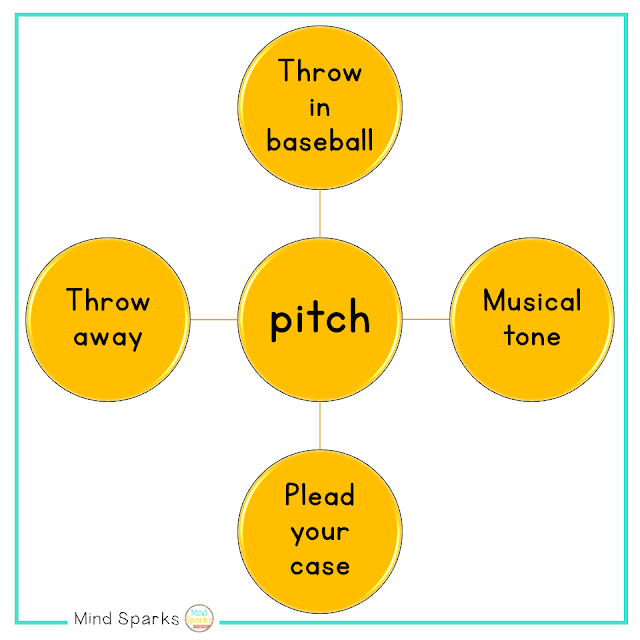After a word is explicitly taught, students need MULTIPLE exposures of the word in order to "own" it. These encounters should be intentional, spread out and reviewed frequently.
The best way to provide ownership of a word is by learning words in relation to other words.
Our brain loves patterns, so it likes to organize our mental dictionary by building connections among words that are learned. Our brain creates networks of words that have similar features like the ones listed below:
- phonological
- semantic
- morphological
- orthographic
- visual
- emotional
1. Multiple Meanings
Does the vocabulary word you are teaching have multiple meanings? If so--point that out! Did you know out of the 5,000 or so most common words in English, many of them have multiple meanings. Therefore, lots of opportunities will present themselves to dialogue about the multiple meanings.
Example: hit, jam, check, frame, etc.
A simple word map (pictured below) helps students see the multiple meanings a word can have.
2. Classify Words into Categories
As I mentioned before, our brains crave organization and patterning. As we learn words, our brains are creating pathways to connect new words with known words. Every word in your mental dictionary is connected to other words, ideas or images.
Help students truly understand a vocabulary term by facilitating connections. Some great classification activities include the following:
- Open sorts--give students a group of words and have them group the words how they see fit.
- Identification of categories--show students a group of words that go together and have them determine a category label.
3. Analyze Semantic Features
Semantic feature analysis is a strategy to compare characteristics of words. Many words have some in-common properties and identifying these properties helps students create those ever important word networks! When we help students connect one word to an already known word, we deepen their understanding of the term.
Semantic feature analysis can be done with a simple chart as pictured below:
Check out Semantic Feature Analysis from Reading Rockets. This article takes a deeper dive into analyzing characteristics of words, and you can even download a free semantic feature analysis grid!!
4. Use Antonyms
Antonyms are words of opposite meanings. Identifying antonyms of vocabulary terms deepens a student's understanding of the word. This is one more way to teach words in relation to other words.
5. Use Synonyms
Synonyms are words with the same meanings. Identifying synonyms for vocabulary terms helps students create relationships in meaning among the words. There is often a shade of meaning that distinguishes one synonym from another---making one word a better choice than another. Again--the point is that you are facilitating the creation of "word networks" for students. AND....our brains LOVE word networks!
If you are looking for more strategies on vocabulary instruction, check out Reading 101: A Guide to Teaching Reading and Writing from Reading Rockets. This article has tons of great tips and instructional strategies!





No comments:
Post a Comment